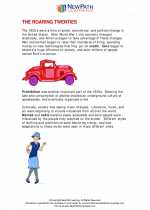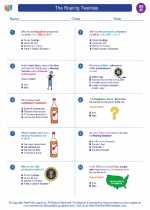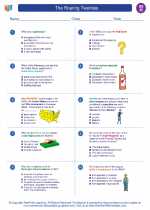The Roaring Twenties
The 1920’s were a time of social, economical, and political change in the United States. After World War I, the economy changed drastically. Men and women began to raise their standards of living, spending money on new technologies that they put on credit. Cars began to become a huge influence on society, and soon millions of people owned Ford’s invention. Read More...
◂Social Studies Worksheets and Study Guides Eighth Grade. The Roaring Twenties
Study Guide The Roaring Twenties
The Roaring Twenties  Worksheet/Answer key
Worksheet/Answer key The Roaring Twenties
The Roaring Twenties  Worksheet/Answer key
Worksheet/Answer key The Roaring Twenties
The Roaring Twenties  Worksheet/Answer key
Worksheet/Answer key The Roaring Twenties
The Roaring Twenties 

 Worksheet/Answer key
Worksheet/Answer key
 Worksheet/Answer key
Worksheet/Answer key
 Worksheet/Answer key
Worksheet/Answer key

The resources above cover the following skills:
National Curriculum Standards for Social Studies (NCSS)
TIME, CONTINUITY, AND CHANGE
SOCIAL STUDIES PROGRAMS SHOULD INCLUDE EXPERIENCES THAT PROVIDE FOR THE STUDY OF THE PAST AND ITS LEGACY.
KNOWLEDGE - Learners will understand:
Concepts such as: chronology, causality, change, conflict, complexity, multiple perspectives, primary and secondary sources, and cause and effect.
National Standards for Civics and Government (NSCG)
What are the foundations of the American political system? What are the distinctive characteristics of American society?
Distinctive characteristics of American society. Students should be able to identify and explain the importance of historical experience and geographic, social, and economic factors that have helped to shape American society. To achieve this standard, students should be able to
Explain important factors that have helped shape American society
Relative geographic isolation
How does the government established by the constitution embody the purposes, values, and principles of American democracy? What does the national government do?
Major responsibilities for domestic and foreign policy. Students should be able to explain the major responsibilities of the national government for domestic and foreign policy. To achieve this standard, students should be able to
Identify historical and contemporary examples of important foreign policies, e.g., Monroe Doctrine, Marshall Plan, immigration acts, foreign aid, arms control, promoting democracy and human rights throughout the world
What is the relationship of the United States to other nations and to world affairs? How is the world organized politically?
United States' relations with other nation-states. Students should be able to explain how United States foreign policy is made and the means by which it is carried out. To achieve this standard, students should be able to
Describe various means used to attain the ends of United States foreign policy, e.g., diplomacy; economic, military, and humanitarian aid; treaties; trade agreements; incentives; sanctions; military intervention; covert action
National Center for History in Schools (NCHS)
Historical Thinking Standards
Historical Comprehension
Reconstruct the literal meaning of a historical passage.
Historical Analysis and Interpretation
Analyze cause-and-effect relationships and multiple causation, including the importance of the individual, the influence of ideas.
United States History Content Standards
Era 7: The Emergence of Modern America (1890-1930)
The changing role of the United States in world affairs through World War I.
The student understands the impact at home and abroad of the United States involvement in World War I.
How the United States changed from the end of World War I to the eve of the Great Depression.
The student understands how new cultural movements reflected and changed American society.
Era 10: Contemporary United States (1968 to the present)
Recent developments in foreign and domestic politics.
The student understands domestic politics in contemporary society.
World History Content Standards
Era 8: A Half-Century of Crisis and Achievement, 1900-1945
The search for peace and stability in the 1920s and 1930s.
The student understands the interplay between scientific or technological innovations and new patterns of social and cultural life between 1900 and 1940.
The student understands the interplay of new artistic and literary movements with changes in social and cultural life in various parts of the world in the post-war decades.
Major global trends from 1900 to the end of World War II.
The student understands major global trends from 1900 to the end of World War II.